-
Use Cases
-
Resources
-
Pricing
Economic Transformations
The First Industrial Revolution
1760 - 1840
% complete
The First Industrial Revolution was a period of major industrialization that took place during the late 18th century and early 19th century. It was characterized by the transition from hand production methods to machine production, the development of new technologies, and the growth of factory systems. This revolution had a profound impact on society, bringing about significant changes in agriculture, manufacturing, mining, transportation, and communication.
Image source: Industrial Revolution
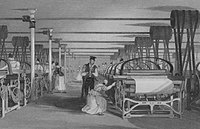
The Second Industrial Revolution
1840 - 1914
% complete
The Second Industrial Revolution, also known as the Technological Revolution, was a period of rapid industrialization and innovation that occurred from the mid-19th century to the early 20th century. It was characterized by the widespread adoption of new technologies such as the telegraph, telephone, electricity, and the development of new industries such as steel, chemicals, and petroleum. This period saw significant improvements in transportation, communication, and manufacturing processes, leading to increased productivity and economic growth.
Image source: Second Industrial Revolution
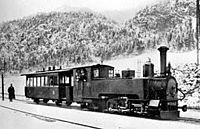
The Irish Potato Famine
1845 - 1852
% complete
The Irish Potato Famine was a period of mass starvation and disease in Ireland from 1845 to 1852. It is also known as the Great Famine or the Great Hunger. The famine was caused by a potato blight that destroyed the country's main food crop, the potato. This led to a severe food shortage and the death of approximately one million people. Additionally, many Irish people emigrated to escape the famine, resulting in a significant population decline.
Image source: Great Famine (Ireland)

The Great Exhibition in London
1851
% complete
The Great Exhibition in London was the first international exhibition of its kind, showcasing a wide range of industrial and technological advancements. It was held in Hyde Park from May 1 to October 15, 1851. The exhibition featured over 100,000 exhibits from around the world and attracted more than six million visitors. The Crystal Palace, a large glass and iron structure, was built specifically for the exhibition and became a symbol of the Industrial Revolution.
Image source: Great Exhibition

Political and Legislative Changes
The Enclosure Acts
1760 - 1840
% complete
The Enclosure Acts were a series of laws enacted in England and Wales between 1760 and 1840. These laws allowed landowners to enclose and consolidate their land, converting common and open fields into privately owned agricultural fields. The goal of the Enclosure Acts was to increase agricultural productivity and efficiency, but they also resulted in the displacement of rural communities and the loss of common grazing and agricultural land for many individuals.
The Factory Act of 1774
1774
% complete
The Factory Act of 1774 was an Act passed by the British Parliament to regulate the working conditions in textile factories. It limited the working hours of apprentices and provided for their education. The Act also required factories to have sufficient lighting and ventilation, and prohibited the employment of children under the age of 6. This Act was one of the first attempts to protect the rights of workers in the early stages of the Industrial Revolution.
The American Revolution
1775 - 1783
% complete
The American Revolution was a conflict between Great Britain and thirteen of its North American colonies, which had declared themselves the independent United States of America. The war lasted from 1775 to 1783 and resulted in the United States gaining independence from Britain.
Image source: American Revolution

The First Factory Act
1802
% complete
The First Factory Act was an act of the Parliament of the United Kingdom which restricted the working hours of women and children in textile mills to 12 hours per day. It also required children between the ages of 9 and 13 to receive 2 hours of education per day. The act was the first attempt to regulate working conditions in factories and protect the rights of workers.
The Embargo Act of 1807
1807
% complete
The Embargo Act of 1807 was a law passed by the United States Congress on December 22, 1807. It prohibited American ships from trading with foreign nations in an attempt to protect American interests during the Napoleonic Wars. The act was intended to force Britain and France to respect American neutrality and stop interfering with American trade. However, it had a negative impact on the American economy, particularly in New England where many people depended on trade with Europe. The act was repealed in 1809.
Image source: Embargo Act of 1807

The Factory Act of 1833
1833
% complete
The Factory Act of 1833 was an Act of the Parliament of the United Kingdom that regulated the conditions of industrial employment. It was the first comprehensive attempt to set limits on the hours worked by children and women in industrial establishments. The act prohibited the employment of children under nine years of age, restricted the working hours of children aged 9-13 to a maximum of nine hours per day, and required factory owners to provide education for children working in their factories. It also imposed restrictions on the employment of women and introduced inspectors to enforce the provisions of the act.
The Mines Act of 1842
1842
% complete
The Mines Act of 1842 was an act of the Parliament of the United Kingdom that prohibited underground work for all women and girls, as well as for boys under the age of 10. The act aimed to improve working conditions in coal mines and reduce the exploitation of women and children.
The Corn Laws repealed
1846
% complete
The Corn Laws were a series of tariffs and restrictions imposed on imported grain in the United Kingdom. These laws were enacted to protect domestic agriculture and maintain high prices for British farmers. However, they resulted in high food prices and limited access to cheap grain for the working class. In 1846, the Corn Laws were repealed, leading to the abolition of import duties on grain. This decision was influenced by the Great Famine in Ireland, which highlighted the need for free trade in food. The repeal of the Corn Laws marked a significant shift towards free trade in the UK and had a profound impact on agriculture and the economy.
Image source: Corn Laws
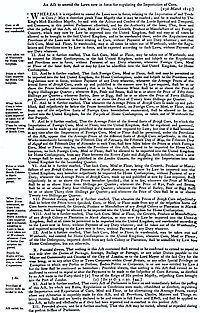
The Factory Act of 1847
1847
% complete
The Factory Act of 1847 was an amendment to the previous Factory Act of 1833. It was passed in the United Kingdom and aimed to further regulate the working conditions in factories. The act limited the working hours for women and young persons between 13 and 18 years old to 10 hours a day. It also introduced a system of factory inspectors to ensure compliance with the regulations. The Factory Act of 1847 was a significant step towards improving the welfare of workers in the Industrial Revolution.
The Factory Act of 1850
1850
% complete
The Factory Act of 1850 was an Act of the Parliament of the United Kingdom that sought to improve conditions for children working in factories. It introduced a maximum 10-hour working day for children aged 13 to 18 and limited the working hours of children aged 9 to 12 to 12 hours a day. The Act also prohibited the employment of children under the age of 9 in textile mills.
The Crimean War
1853 - 1856
% complete
The Crimean War was a conflict fought between the Russian Empire and an alliance of the Ottoman Empire, France, Britain, and Sardinia from 1853 to 1856. It originated from a dispute over the rights of Christians in the Holy Land, which was then part of the Ottoman Empire. The war was mainly fought on the Crimean Peninsula in the Black Sea, with several major battles taking place there. The war resulted in significant casualties and brought about important changes in military tactics and medical care. It also highlighted the need for reform in the British army and led to the establishment of the modern nursing profession by Florence Nightingale.
Image source: Crimean War

The Factory Act of 1853
1853
% complete
The Factory Act of 1853 was an Act of the Parliament of the United Kingdom which sought to regulate the conditions of employment in industrial factories. It set the maximum working hours for women and young persons, established regulations for the cleanliness and ventilation of factories, and required the provision of adequate sanitary facilities. The Act also introduced measures to prevent accidents and improve safety in factories.
Image source: Factory Acts

The Factory Act of 1856
1856
% complete
The Factory Act of 1856 was an act passed by the British Parliament to regulate the working conditions in textile factories. It limited the working hours for women and young people, introduced meal breaks, and improved the safety measures in factories. The act also established a minimum age for employment and required factory owners to provide education for children working in their factories. The Factory Act of 1856 was a significant step towards improving the welfare and rights of factory workers during the Industrial Revolution.
The Factory Act of 1859
1859
% complete
The Factory Act of 1859 was a piece of legislation in the United Kingdom that aimed to improve the working conditions of women and children in factories. It introduced restrictions on the employment of women and children, including limitations on working hours and the establishment of a maximum working age. The act also mandated the provision of education for child workers and improved the inspection and enforcement of factory regulations.
The Factory Act of 1864
1864
% complete
The Factory Act of 1864 was a British law that aimed to improve working conditions in factories. It limited the number of hours that women and young persons could work to 56 hours per week, and prohibited the employment of children under the age of 8. The act also introduced stricter regulations regarding health, safety, and cleanliness in factories.
The Factory Act of 1867
1867
% complete
The Factory Act of 1867, also known as the Althorp Act, was an Act of Parliament in the United Kingdom that introduced several regulations to improve the conditions of factory workers. The act established the legal working hours, prohibited the employment of young children, and introduced safety measures in factories. It also required factory owners to provide proper ventilation, sanitation, and lighting in the workplace. The Factory Act of 1867 was a significant milestone in the development of worker protection laws and set a precedent for future labor legislation.
The Factory Act of 1874
1874
% complete
The Factory Act of 1874 was an Act of the Parliament of the United Kingdom that expanded on previous legislation governing the working conditions in factories. It introduced new regulations related to the employment of women and children, including restrictions on the number of hours they could work and provisions for their safety and welfare. The Act also established stricter inspections and penalties for non-compliance. The Factory Act of 1874 was an important milestone in improving working conditions and protection for workers during the Industrial Revolution.
The Factory Act of 1878
1878
% complete
The Factory Act of 1878 was an important piece of legislation in the history of the Industrial Revolution. It aimed to improve the working conditions for factory workers, particularly women and children. The act established stricter regulations on working hours, health and safety standards, and the employment of children. It also introduced penalties for non-compliance. The Factory Act of 1878 marked a significant step towards the protection of workers' rights and the improvement of working conditions in factories.
The Factory Act of 1891
1891
% complete
The Factory Act of 1891 was an Act of the Parliament of the United Kingdom that aimed to improve the working conditions in factories. It introduced certain restrictions on the working hours of women and children, as well as provisions for their safety and welfare. The Act also established a requirement for the periodic inspection of factories by government inspectors. Overall, the Factory Act of 1891 was a significant step towards protecting the rights and well-being of workers during the Industrial Revolution.
The Factory Act of 1895
1895
% complete
The Factory Act of 1895 was a piece of UK legislation that aimed to improve the working conditions of employees in factories. It introduced several regulations, including limiting the working hours of women and young persons to 56 hours per week, restricting the employment of children under the age of 11, and requiring factory owners to provide basic sanitary facilities and fencing around dangerous machinery. The Act also introduced the requirement for factory inspectors to enforce these regulations and carry out regular inspections. Overall, the Factory Act of 1895 was an important step towards improving the rights and safety of factory workers during the Industrial Revolution.
Image source: Factory and Workshop Act 1895

The Factory Act of 1901
1901
% complete
The Factory Act of 1901 was a British law that aimed to improve working conditions in factories. It introduced regulations regarding the hours of work, health and safety measures, and the employment of children and young persons. The Act limited the working hours for women and young persons to 60 hours per week and prohibited their employment at night. It also established a system of factory inspection to ensure compliance with the law. The Factory Act of 1901 was an important milestone in the ongoing effort to protect workers and improve industrial working conditions.
The Factory Act of 1907
1907
% complete
The Factory Act of 1907 was a piece of legislation in the United Kingdom that aimed to improve the working conditions of workers in factories. It introduced several regulations, including limiting the working hours for women and young persons, increasing the minimum working age to 14, and requiring the provision of adequate sanitary facilities. The act also established a system of factory inspections to ensure compliance with the new regulations.
Inventions and Technological Advances
Invention of the Spinning Jenny
1764
% complete
The Spinning Jenny was invented by James Hargreaves, a weaver from Lancashire, England, in the year 1764. It was a multi-spindle spinning frame that allowed one person to spin multiple threads at the same time. This invention significantly increased the productivity of the textile industry and played a crucial role in the Industrial Revolution.
Image source: Spinning jenny
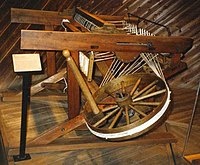
James Watt patents the steam engine
1769
% complete
James Watt patents the steam engine in 1769. This invention greatly improved the efficiency and power of steam engines, leading to their widespread use in factories and transportation. Watt's improved design included a separate condenser, which made the engine more efficient and reduced fuel consumption. This development played a crucial role in the progress of the industrial revolution by revolutionizing manufacturing, transportation, and the overall productivity of society.
Image source: Watt steam engine

Arkwright's water frame
1769
% complete
Arkwright's water frame was a spinning machine designed and patented by Sir Richard Arkwright in 1769. It was powered by water and used a series of rollers and spinning frames to produce yarn. The water frame revolutionized the textile industry by increasing the efficiency and productivity of textile production, leading to the growth of factories and the mass production of yarn.
The Spinning Mule
1779
% complete
The Spinning Mule was a machine used in the textile industry for spinning cotton and other fibers. It was invented by Samuel Crompton in 1779. The Spinning Mule combined features of the spinning jenny and the water frame, allowing for greater productivity and finer yarn production. It played a significant role in the industrialization of the textile industry.
Image source: Spinning mule

Watt's improved steam engine
1781
% complete
Watt's improved steam engine was patented by Scottish engineer James Watt in 1781. This steam engine was a significant improvement over the existing steam engines of the time and played a crucial role in the Industrial Revolution. Watt's steam engine was more efficient and had a separate condenser that reduced fuel consumption and increased power output. This invention transformed industries such as mining, transportation, and manufacturing, leading to increased productivity and economic growth.
The Power Loom
1784
% complete
The Power Loom was a mechanized loom that was designed and constructed by Edmund Cartwright in 1784. It used water power to operate and was capable of weaving fabric much faster and more efficiently than traditional hand looms. The Power Loom revolutionized the textile industry and played a central role in the Industrial Revolution.
Image source: Power loom
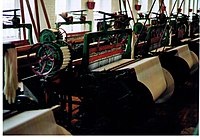
The Steamboat
1787
% complete
The steamboat, also known as a steamship or paddle steamer, is a boat in which the primary motive power is steam, typically driving propellers or paddlewheels. The steamboat was first developed in the late 18th century and became a popular mode of transportation during the Industrial Revolution. One of the earliest successful steamboats was the Clermont, built by Robert Fulton in 1807. The steamboat revolutionized transportation by allowing ships to move against strong river currents and to travel faster and more efficiently than traditional sailing vessels. The steamboat played a significant role in the expansion of trade and commerce during the Industrial Revolution.
Image source: Steamboat

The Cotton Gin
1793
% complete
The Cotton Gin was invented by Eli Whitney in 1793. It was a machine that revolutionized the cotton industry by dramatically increasing the efficiency of removing seeds from cotton fibers. Before the invention of the cotton gin, this process was done by hand, which was time-consuming and labor-intensive. The cotton gin made it possible to produce cotton on a large scale, leading to a boom in the cotton industry and the spread of slavery in the American South.
Image source: Cotton gin

The Steam-powered Printing Press
1814
% complete
The Steam-powered Printing Press was invented by Friedrich Koenig in 1814. It was the first printing press powered by steam and greatly increased the speed and efficiency of printing. This invention had a significant impact on the publishing industry, allowing for the mass production of books, newspapers, and other printed materials.
Image source: Printing press
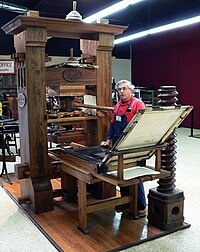
The Telegraph
1837
% complete
The Telegraph was a communication device that allowed people to send messages over long distances using electric signals. It was invented in 1837 by Samuel Morse and Alfred Vail. The Telegraph revolutionized communication by enabling messages to be sent quickly and efficiently, replacing the need for physical mail and reducing the time it took to transmit information. This invention had a profound impact on various industries, such as journalism, business, and transportation, and played a crucial role in the development of global communication networks.
The Electric Telegraph
1837
% complete
The Electric Telegraph was a communication system that used electrical signals to transmit messages over long distances. It was developed in the early 19th century and revolutionized communication during the Industrial Revolution. The first commercial telegraph line was opened in 1837, connecting the cities of London and Birmingham in England. The system allowed messages to be sent quickly and accurately, greatly improving the speed and efficiency of communication.
Image source: Electrical telegraph

The Bessemer Process
1856
% complete
The Bessemer Process was developed by English engineer Henry Bessemer in 1856. It was a method of producing steel by blowing air through molten iron to remove impurities and reduce the carbon content. This revolutionary process allowed for the mass production of steel, leading to significant advancements in industrialization and construction.
Image source: Bessemer process
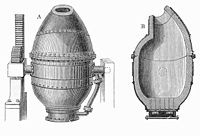
The First Transatlantic Cable
1858
% complete
The First Transatlantic Cable was a submarine telegraph cable that connected Europe and North America. It was laid across the Atlantic Ocean and allowed for near-instantaneous communication between the two continents. The cable was completed in 1858, and the first message was transmitted on August 16, 1858. However, the cable quickly failed and communication was lost after only a few weeks. Despite this setback, the Transatlantic Cable laid the foundation for future submarine telegraph cables, and a successful cable was eventually laid in 1866, establishing permanent telegraph communications between Europe and North America.
Image source: Transatlantic telegraph cable

Social Impact and Labor Movements
The Luddite Riots
1811 - 1816
% complete
The Luddite Riots were a series of violent protests carried out by skilled textile workers in England between 1811 and 1816. The protests were against the use of new machinery in the textile industry, which was seen as a threat to their livelihoods. The Luddites believed that the machines were taking away their jobs and reducing their wages. They destroyed machinery and factories in an attempt to stop the industrialization of the textile industry. The riots were eventually suppressed by the government, and many Luddites were arrested and sentenced to harsh punishments.
Urbanization and Infrastructure Development
The Railroad Boom
1820
% complete
The Railroad Boom refers to the rapid expansion of railway systems in the United States during the 19th century. It started around 1820 and its impact lasted well into the 20th century. The construction of railroads connected various regions, facilitated transportation of goods and people, and spurred economic growth and industrialization.
The Erie Canal opens
1825
% complete
The Erie Canal opens on October 26, 1825. It was a 363-mile waterway connecting the Great Lakes with the Atlantic Ocean via the Hudson River in New York. The canal allowed for easier transportation of goods and significantly reduced the cost of shipping. It played a key role in the development and expansion of industry in the United States.
Image source: Erie Canal
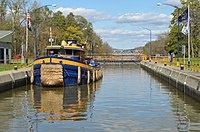
The Crystal Palace is constructed
1850
% complete
The Crystal Palace was a large glass and cast iron structure built in Hyde Park, London, for the Great Exhibition of 1851. It was designed by Joseph Paxton and constructed between 1850 and 1851. The Crystal Palace was a symbol of the Industrial Revolution and showcased the advancements in technology and industry during that time. The building was 1,848 feet long and housed exhibits from all over the world, displaying products and innovations from different industries. It was a groundbreaking architectural and engineering achievement, using innovative techniques and materials like cast iron and glass. The Crystal Palace was visited by millions of people during the Great Exhibition and became an iconic structure of the Industrial Revolution.
Image source: The Crystal Palace
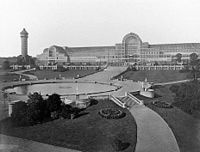
Key Facts
- The Industrial Revolution began in Great Britain in the mid-18th century.
- The invention of the steam engine revolutionized transportation and fueled industrial growth.
- The textile industry was one of the first industries to undergo major mechanization during the Industrial Revolution.
- The factory system emerged, leading to the mass production of goods.
- The Industrial Revolution had significant social and economic impacts, including urbanization, child labor, and class divisions.
Source
This Industrial Revolution timeline was generated with the help of AI using information found on the internet.
We strive to make these timelines as accurate as possible, but occasionally inaccurates slip in. If you notice anything amiss, let us know at [email protected] and we'll correct it for future visitors.
Create a timeline like this one for free
Preceden lets you create stunning timelines using AI or manually.
Customize your timeline with one of our low-cost paid plans
Export your timeline, add your own events, edit or remove AI-generated events, and much more
Free
$
0
free forever
No credit card required.
Basic
$
10
/month
billed annually
Cancel anytime.
Pro
$
16
/month
billed annually
Cancel anytime.
Common Questions
Can I cancel anytime?
Yes. You can cancel your subscription from your account page at anytime which will ensure you are not charged again. If you cancel you can still access your subscription for the full time period you paid for.
Will you send an annual renewal reminder?
Yes, we will email you a reminder prior to the annual renewal and will also email you a receipt.
Do you offer refunds?
Yes. You can email us within 15 days of any payment and we will issue you a full refund.
What if I have more questions?
Check out our pricing docs or send us an email anytime: [email protected].